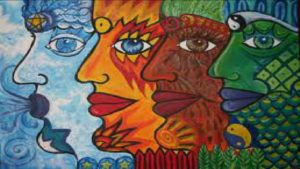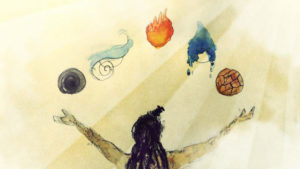सर्वे भवन्तु सुखिनः
‘Sarve Bhavantu Sukhinah’ – II
By ‘Amritavarshini’

Read the previous section of this series here.
Paṇća Mahābhūta and their Role in Wellness
As mentioned in the previous post, Paṇća Mahābhūta or the ‘five elements’ are not only found in nature but also within the human body. In that respect our body can be compared to a small universe. It was therefore natural to make the five elements an integral and inseparable part of all customs and traditions by our ancestors of Indian and Eastern cultures. These customs might have evolved and changed over the centuries and millennia, but the basic concepts ingrained in them have remained unchanged even today.
For our forebears ‘Nature’ was the nurturer as She provided them with food, energy, herbs to cure ailments and provide relief from stress and tension-related mental illnesses, and much more. So they lived in perfect compatibility with nature and the five elements contained therein. As time passed and they began settling down in clusters of civilization, these very bhūtas also became their means of livelihood, transport and proved to be an inexhaustible source of knowledge. The knowledge they thus gained was further enhanced through exploration and a spirit of inquiry by our ancestors, thus creating a treasure trove of wisdom for posterity. So vast and varied is this storehouse of knowledge that it wouldn’t be wrong to say that we are still only skimming the surface.
Realising that they could not live without the help of the bhūtas they began caring for them. It was almost as if they spoke to our ancestors: ‘Use us, but nurture us too and we will be your well-wishers and care-givers in return!’ What a beautiful way of living in interdependence!
There are verses in our Vēdas and Upaniśads that offer prayers to the Paṇća Mahabhūtas of appu/jala, tēyu/agnī, vāyu, pṛthvī and ākāśa. By living closely with the elements, they knew their moods and behaviour—when the weather would be pleasant, when it would turn foul, the change of the seasons, when the rains would be good and when they would fail, and so on. Thus they devised a comfortable and compatible co-existence of humans, other living beings and nature.
While talking of living beings, these can be classified into five divisions—each division possessing a particular number of bhūtas.
-
- The first division is the plant kingdom, the vital element of which is appu (water).
- The second division comprises of those living things that live underground—insects, worms and the like—and consist of two active elements, viz. agnī and pṛthvī (fire and earth).
- Birds belong to the third division and the active elements found in them are agnī, pṛthvī and vāyu (fire, earth and air).
- Animals fall under the fourth category with all the four elements—agnī, appu, pṛthvī and vāyu (fire, water, earth and air) as their active elements.
- Ākāśa (sky/space), is subtle, unlike the other four bhūtas, and does not exist in other living beings but is found in human beings alone along with the other four bhūtas. It is this fifth element, which unites humans with the Superme Power. That is why human beings are considered to be superior to other living beings among all creation.
Our ancestors nurtured and preserved the five elements by living in tune with nature and instituting certain rituals and customs that were beneficial for both living beings and nature. The underlying concept was mutual reverence and nurturing, because each of them involved the use of one more bhūtas, which in turn benefitted the humans. Even a cursory study would reveal the scientific basis of these customs and the beautiful and traditional wisdom that have gone into them.
By cleverly weaving the rituals and customs around divine propitiation in the early years and later around dhārmika duties and social obligations, our wise ancestors ensured that the living beings and nature were cared for.

Interestingly, these rituals and customs exist even today. While many follow it by force of habit or compulsion without understanding the significance behind them, others ignore them completely as being superstition or regressive.
Let us take the customs related to temple pūjā for instance and the bhūtas involved in them.
-
- The foremost one is water. No temple visit is complete without jala is it? For starters, a pilgrimage is known as tīrtha yātra, the reason being that our temples were/are either situated on riverbanks or have temple tanks attached to them—the latter being a part of any medium or large temple—especially in South India. The devotees first take a holy dip in rivers and temple tanks before entering the temple. In all temples the Deity has abhiśekam (ritual bathing) performed by the purōhita. In North India, the devotees themselves offer jala to Shiva in temples (‘jala chaḍhānā’). They drink the abhiśeka tīrtham, or the purōhita sprinkles the tīrtha on the devotees (tīrtha prōkśañam). No wonder water bodies were preserved and kept pure with so much emphasis on the use of jala in temple rituals.
- Large scale havans and yagnas performed in temples induce agnī to clear any pollution of the vāyu in the atmosphere.
- Pṛthvī is conserved by growing plants and trees for producing flowers, and leaves, fruits, and twigs offered in the havans. The flowers and leaves have beneficial medicinal properties that help cure many diseases.
- When these four bhūtas are protected and preserved the fifth one—sky (ākāśa) becomes pristine pure and directly connects the spirit of man to the Divine Force.
It is popularly believed, especially in South India, that Lord Śiva manifests Himself in the form of the paṇćabhūtas in each of the following places of worship, of which four are in Tamil Nadu and one in Andhra Pradesh.
-
- As ‘Prithvi Lingam’ at Kancheepuram
- As ‘Vayu Lingam’ at Kalahasthi
- As ‘Appu Lingam’ at Thiruvanaikaval
- As ‘Agni Lingam’ at Tiruvannamalai
- As ‘Akasha Lingam’ at Chidambaram
To understand paṇćabhūta tatva and the importance of the bhūtas in our lives we should know how these five elements affect our body.
About the author:
‘Amritavarshini’, is a wise elder who has conducted extensive research into the customs and rituals related to health, among rural and tribal communities our country, learning from the wisdom of the elders in these communities and building on them with her own research through drugless therapies of India and the Far East. Her forte lies in integrating the various therapies with a generous dose of spirituality and interesting tales and anecdotes, to help in a healthy lifestyle.
Read the next section of this series here.
